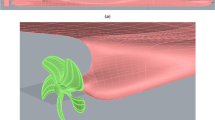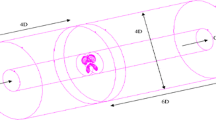Abstract
To minimize the energy consumption of contra-rotating propellers (CRPs), the optimal matched rotational speeds of the forward propeller (FP) and rear propeller (RP) of CRP are investigated based on the potential-based panel method. The optimal matching problem of a set of CRP405 is investigated. The open-water hydrodynamic performances of CRP405 with the FP and RP having the same rotational speed are calculated and the method is validated. The hydrodynamic characteristics of CRP405 with changing FP and RP rotational speeds are investigated. The cubic spline interpolation method is used to determine the equal thrust line at which CRP405 generates the target thrust while keeping the inflow velocity constant. A series of equal thrust points on the equal thrust line is selected for the analysis of the delivered power. The rotational speeds of the FP and RP corresponding to the minimal delivered power are the optimal matched rotational speeds of CRP405. The optimal matching calculations are carried out at different inflow velocities. The results show that, under the condition of a low inflow velocity, properly increasing the rotational speed of the FP and decreasing the rotational speed of the RP are the most direct and efficient ways to reduce the energy consumption and avoid the negative effect of the net torque of the CRP on the transverse stability.


















Similar content being viewed by others
Abbreviations
- \(\rho\) :
-
Water density
- \(V_{0}\) :
-
Inflow velocity
- \(D_{F}\) :
-
Diameter of the FP
- \(D_{R}\) :
-
Diameter of the RP
- \(n_{F}\) :
-
Rotational speed of the FP
- \(n_{R}\) :
-
Rotational speed of the RP
- \(Q_{F}\) :
-
Torque of the FP
- \(Q_{R}\) :
-
Torque of the RP
- \(T_{F}\) :
-
Thrust of the FP
- \(T_{R}\) :
-
Thrust of the RP
- \(T_{S} = T_{F} + T_{R}\) :
-
Total thrust of CRP
- \(P_{{{\text{d}}F}} = 2\pi Q_{F} \cdot n_{F}\) :
-
Delivered power of the FP
- \(P_{{{\text{d}}R}} = 2\pi Q_{R} \cdot n_{R}\) :
-
Delivered power of the RP
- \(P_{{{\text{d}}S}} = P_{{{\text{d}}F}} + P_{{{\text{d}}R}}\) :
-
Total delivered power of CRP
- \(K_{TF} = \frac{{T_{F} }}{{\rho n_{F}^{2} D_{F}^{4} }}\) :
-
Thrust coefficient of the FP
- \(K_{TR} = \frac{{T_{R} }}{{\rho n_{F}^{2} D_{F}^{4} }}\) :
-
Thrust coefficient of the RP
- \(K_{QF} = \frac{{Q_{F} }}{{\rho n_{F}^{2} D_{F}^{5} }}\) :
-
Torque coefficient of the FP
- \(K_{QR} = \frac{{Q_{R} }}{{\rho n_{F}^{2} D_{F}^{5} }}\) :
-
Torque coefficient of the RP
- \(J = \frac{{V_{0} }}{{n_{F} D_{F} }}\) :
-
Advance coefficient
References
Osborne M (2012) Design constraints limit options for EEDI compliance. Naval Architect 25(1):4–27
Hou LX, Wang CH, Hu AK, Han FL (2015) Wake-adapted design of fixed guide vane type energy saving device for marine propeller. Ocean Eng 110:11–17
Lerbs E (1955) Contra-rotating optimum propeller operating in a radially non-uniform wake. Report from Defense Technical Information Center, Ft Belvoir
Miller ML (1976) Experimental determination of unsteady forces on contra-rotating propellers in uniform flow. Report from David W Taylor NSR&D Center, Bethesda
Gu H, Kinnas SA (2003) Modeling of contra-rotating and ducted propellers via coupling of a vortex-lattice with a finite volume method. In: Proceedings of Propellers/Shafting 2003 Symposium, Society of Naval Architects and Marine Engineers, Virginia Beach
Ghassemi H (2009) Hydrodynamic performance of coaxial contra-rotating propeller (CCRP) for large ships. Polish Maritime Res 16(1):22–28
Min KS, Chang BJ, Seo HW (2009) Study on the contra-rotating propeller system design and full-scale performance prediction method in rapid hull form generation. Int J Naval Architect Ocean Eng 1(1):29–39
Kravitz E (2011) Analysis and experiments for contra-rotating propeller. Massachusetts Institute of Technology, Cambridge
Taheri R, Shaygani A, Zare AA, Mazaheri K (2013) Hydrodynamic optimization of marine propeller and numerical investigation of contra-rotating propeller. Majlesi J Energy Manag 2(1):15–21
Ghassemi H, Taherinasab M (2013) Numerical calculations of the hydrodynamic performance of the contra-rotating propeller (CRP) for high speed vehicle. Polish Maritime Res 20(2):13–20
Wang ZZ, Xiong Y (2013) Effect of time step size and turbulence model on the open water hydrodynamic performance prediction of contra-rotating propellers. China Ocean Eng 27(2):193–204
Paik KJ, Hwang S, Jung J, Lee T, Lee YY, Ahn H, Van SH (2015) Investigation on the wake evolution of contra-rotating propeller using RANS computation and SPIV measurement. Int J Naval Architect Ocean Eng 7(3):595–609
Paik KJ (2017) Numerical study on the wake evolution of contra-rotating propeller in propeller open water and self-propulsion conditions. Brodogradnja 68(1):125–138
Mohammad NN, Saber M, Masoud Z (2018) Optimization of a marine contra-rotating propellers set. Ocean Eng 167:397–404
Hu J, Wang YZ, Zhang WP, Chang X, Zhao W (2019) Tip vortex prediction for contra-rotating propeller using large eddy simulation. Ocean Eng 194:1064101–10641017
Hou LX, Hu AK (2018) Numerical design of contra-rotating azimuth propulsor using vortex theory coupled with panel method. Ocean Eng 156:512–522
Hou LX, Hu AK, Wang S (2019) Energy saving performance analysis of contra-rotating azimuth propulsor. Part 2: Optimal matching investigation in model scale. Appl Ocean Res 88:29–36
Hsin CY (1990) Development and analysis of panel methods for propellers in unsteady flow. Department of Ocean Engineering, Massachusetts Institute of Technology, Cambridge
Morino L, Chen L, Suciu E (1975) Steady and oscillatory subsonic and supersonic aerodynamics around complex configurations. AIAA J 13(3):368–374
Achkinadze AS, Berg A, Krasilnikov V, Stepanov IE (2003) Numerical analysis of podded and steering systems using a velocity based source boundary element method with modified trailing edge. In: Proceedings of the propellers/shafting symposium, SNAME
Liu YB (2013) Study on design method of pump jet thruster for underwater vehicles. Harbin Engineering University, School of Shipbuilding Engineering, Harbin
Acknowledgement
This research is financially supported by the Liaoning Provincial Natural Science Foundation of China (Grant No. 2019ZD0161).
Author information
Authors and Affiliations
Corresponding author
Additional information
Publisher's Note
Springer Nature remains neutral with regard to jurisdictional claims in published maps and institutional affiliations.
About this article
Cite this article
Hou, L., Yin, L., Hu, A. et al. Optimal matching investigation of marine contra-rotating propellers for energy consumption minimization. J Mar Sci Technol 26, 1184–1197 (2021). https://doi.org/10.1007/s00773-021-00809-x
Received:
Accepted:
Published:
Issue Date:
DOI: https://doi.org/10.1007/s00773-021-00809-x




